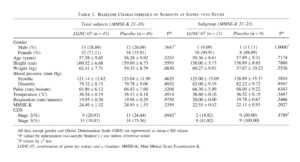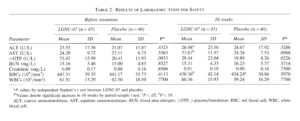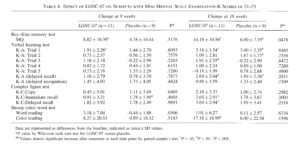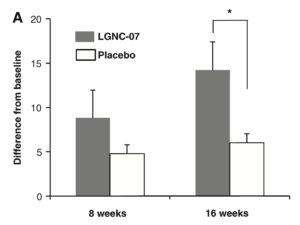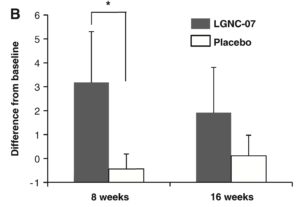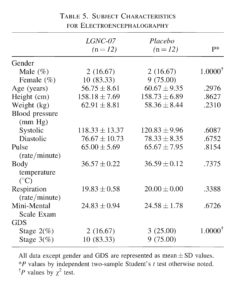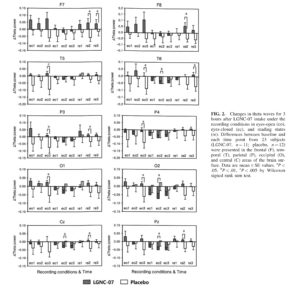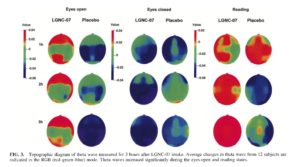A Combination of Green Tea Extract and L-Theanine Improves Memory and Attention in Subjects with Mild Cognitive Impairment:
A Double-Blind Placebo-Controlled Study
Sang-Ki Park,1,2 1 In-Chul Jung,3 1 Won Kyung Lee,1 Young Sun Lee1 Hyoung Kook Park1 Hyo Jin Go,4 Kiseong Kim,5 Nam Kyoo Lim,6 Jin Tae Hong,2 Sun Yung Ly,7 and Seok Seon Rho8
7LG Household and Health Care Co., Ltd.; 3Department of Neuropsychiatry, College of Traditional Korean Medicine, Daejeon University, Dunsan Medical Center; 4Department of Psychiatry, College of Medicine, Catholic University, Daejeon St. Mary Medical Hospital; 5Laxtha Institute of Technology; 7Department of Food Nutrition, College of Human Ecology, Chungnam National University, Daejeon; 6Human Ecology Institute, Yonsei University, Seoul; 2Department of Pharmacy,
College of Pharmacy, Chungbuk National University; and 8Department of Ophthalmology, Otolaryngology and Dermatology, College of Traditional Korean Medicine, Daejeon University, Cheongju Medical Center, Cheongju, Korea
ABSTRACT A combination of green tea extract and L-theanine (LGNC-07) has been reported to have beneficial effects on cognition in animal studies. In this randomized, double-blind, placebo-controlled study, the effect of LGNC-07 on memory and attention in subjects with mild cognitive impairment (MCI) was investigated. Ninety-one MCI subjects whose Mini Mental State Examination-K (MMSE-K) scores were between 21 and 26 and who were in either stage 2 or 3 on the Global Deterioration Scale were enrolled in this study. The treatment group (13 men, 32 women; 57.58 ±9.45 years) took 1,680 mg of LGNC-07, and the placebo group (12 men, 34 women; 56.28 ± 9.92 years) received an equivalent amount of maltodextrin and lactose for 16 weeks. Neuropsychological tests (Rey-Kim memory test and Stroop color-word test) and electroencephalography were conducted to evaluate the effect of LGNC-07 on memory and attention. Further analyses were stratified by baseline severity to evaluate treatment response on the degree of impairment (MMSE-K 21-23 and 24-26). LGNC-07 led to improvements in memory by marginally increasing delayed recognition in the Rey-Kim memory test (P = .0572). Stratified analyses showed that LGNC-07 improved memory and selective attention by significantly increasing the Rey-Kim memory quotient and word reading in the subjects with MMSE-K scores of 21-23 (LGNC-07, w=ll; placebo, n = 9). Electroencephalograms were recorded in 24 randomly selected subjects hourly for 3 hours in eye-open, eye-closed, and reading states after a single dose of LGNC-07 (LGNC-07, n— 12; placebo, n — 12). Brain theta waves, an indicator of cognitive alertness, were increased significantly in the temporal, frontal, parietal, and occipital areas after 3 hours in the eye-open and reading states. Therefore, this study suggests that LGNC-07 has potential as an intervention for cognitive improvement.
KEY WORDS: • attention • electroencephalography • green tea • memory • neuropsychological test • L-theanine
INTRODUCTION
COGNITION-RELATED MENTAL PROBLEMS as a Social issue in modem society are growing in importance because they are often associated with individual survival, professional life, and the economy. Reports about subjective memory complaints (SMCs) indicate that the prevalence of these problems in communities is between 20% and 50%, depending on the study.1,2 Several studies have shown that these problems are also associated with depression, anxiety,
and a higher level of education.3 Although it is still controversial whether SMCs result in future cognitive decline,4 SMC is acknowledged as an initial criterion of mild cognitive impairment (MCI), a transitional state between cognitive decline due to normal aging and mild Alzheimer’s disease (AD).5 MCI is defined as a deficit in memory performance with normal cognitive function in the absence of a diagnosis of AD.6 Early diagnosis of MCI subjects shows that they are at high risk of AD conversion. From 10% to 15% of MCI subjects have been reported to progress to AD within a year, whereas only 1-2% of the normal elderly population showed AD conversion.7 In 2008, the incidence of MCI in those aged over 65 years in Korea was estimated to be 24.08%, or 1,207,836 people (425,593 men and 781,243 women).8
Researchers have reported the ameliorating effect of nutraceutical ingredients such as ginkgo extract and soy
proteins containing isoflavone on cognitive decline;9,10 however, the outcomes have not been satisfactory. Oral AD therapeutics such as donepezil hydrochloride (Aricept®, Pfizer, New York, NY, USA) do not improve MCI and have undesirable side effects such as nausea, diarrhea, depression, and insomnia, among others.
LGNC-07 is a nutraceutical ingredient that contains green tea extract (GTE) and L-theanine. GTE has been consumed on a daily basis in many Asian countries, and its neuro-protective effects have been studied by many researchers. Lee et al.n reported that GTE attenuated neuroblastoma cell death induced by amyloid ft (A/?), which is regulated through nuclear factor /cB, extracellular signal-regulated kinase, and p38 mitogen-activated protein kinase pathways. Anticholinesterase activity in both human and animal erythrocytes suggests the potential retardation of the progression of cognitive impairment.12,13 L-Theanine is well known for its relaxing effect on mental stress,14,15 and further research has demonstrated its memory improvement ability in a scopolamine-induced animal study.16 In our previous studies, LGNC-07 led to an improvement in memory and learning in cognition impairment animal models. Scopolamine-induced memory impairment was ameliorated by inhibiting acetylcholinesterase activity,17 and protection against cell death and secretase inactivation were shown to contribute to memory improvement in the A/?i_42 animal model.18
Cognitive changes in healthy or elderly subjects by memory-enhancing agents have been assessed by electroencephalography (EEG) as well as by neuropsychological tests.19-25 It was reported that the theta power spectrum was related to active mental performance such as learning and goal-driven tasks.24,25 However, there have been no studies about the effect of LGNC-07 on cognitive function using neuropsychological testing and EEG in human subjects.
In this study, a placebo-controlled double-blind clinical study was conducted to investigate whether LGNC-07 can improve cognition using the Rey-Kim memory test, Stroop color-word reading test, and EEG on MCI subjects. It was shown that LGNC-07 increased the Rey-Kim memory quotient (MQ) and correct count of Stroop word reading, suggesting potential memory- and attention-enhancing ability of LGNC-07 in subjects with moderate to severe MCI. In addition, LGNC-07 was shown to regulate the activity of the theta power spectrum, which further indicates that it is a promising nutraceutical candidate for the improvement of cognition.
SUBJECTS AND METHODS
Subjects
This study was conducted at Daejeon University Oriental Hospital (Daejeon, Republic of Korea) from January 1, 2008 to March 31, 2009. Ninety-one participants (25 men and 66 women) with SMCs (including MCI) were enrolled in this study. The study protocol was approved by the Daejeon University Oriental Hospital Institutional Review Board. Subjects were voluntarily recruited through institutional
advertisements such as internet postings and posters. All subjects signed informed consents after having the study purpose, procedures, randomization, possible risk, discomforts, and guaranteed confidentiality explained. Baseline medical and personal information were gathered at their first visit, including variables such as demographic information, disease history, chest x-ray, and electrocardiogram. Blood and urine laboratory analyses and a basic neuropsychological test (Mini Mental Scale Examination-K [MMSE-K] and Global Deterioration Scale [GDS]) were performed to determine inclusion and exclusion of subjects. Inclusion criteria were as follows: (1) age between 40 and 75 years, (2) Korean literacy, (3) subjective memory complaint, (4) a MMSE-K score of 21-26, and (5) second or third stage of GDS. Subjects were excluded if their symptoms lasted less than a month or they were mentally handicapped, were diagnosed with AD, had other neuropsychological disorders that may have affected cognitive function, abused alco-hol/drugs, had liver cirrhosis, had chronic renal failure, were pregnant, were caffeine sensitive or had other serious medical conditions. Food and beverages containing caffeine were restricted during the study period.
Study design
Subjects were assigned to either the placebo or the treatment group by balanced block randomization and instructed to take two 430-mg capsules of treatment or placebo twice a day 30 minutes after meals for 16 weeks. Treatment capsules contained 360 mg of GTE, 60 mg of l-theanine, 5.7 mg of silicone dioxide, and 4.3 mg of magnesium stearate. The placebo contained the same ingredients except for the GTE and L-theanine. The GTE and L-theanine were replaced with 258 mg of maltodextrin and 162 mg of lactose. Concurrent administration of medicine that might affect cognitive function was prohibited, and subjects were put on a 15-day washout period before treatment was initiated. Additional treatments that might affect cognitive function were restricted, and all procedures were conducted by an oriental medicine physician with more than 1 year of experience. Capsules were provided monthly, and any capsules remaining after the study period were counted to evaluate subject compliance.
Neuropsychological tests were performed at baseline and at 8 and 16 weeks after treatment. Adverse events were monitored during the entire study period, and blood analyses were done to evaluate safety.
Neuropsychological tests
MMSE-K. The MMSE-K is the Korean version of the MMSE and is designed to measure various cognitive functions within 10 minutes, with scores ranging from 0 to 30.26 This instrument is used to assess moderate to severe AD patients and includes cognitive domains such as memory, orientation, language, and attention/concentration.
GDS. The GDS is a test used to assess clinical symptoms and severity of AD (or dementia). It consists of a
description of seven major, clinically distinguishable dementia stages, ranging from “no cognitive decline” (GDS 1) to “very severe” (GDS 4-7), with “normal with subjective memory impairment” (GDS 2) and “mild dementia” (GDS 3) as the intermediate stages.27
Rey-Kim memory test. The Rey-Kim memory test is a standardized Korean version of the Rey Auditory Verbal Learning Test.28,29 It contains a Verbal Learning Test (K-AVLT) for verbal memory and a Complex Figure Test (K-CFT) for visuospatial memory. The K-AVLT includes five successive presentations of 15 words followed by a free recall, a 20-minute delayed recall, and a 20-minute delayed recognition trial. For the K-CFT test, copy, immediate recall, and delayed recall were performed 0 and 20 minutes after drawing a diagram from the Rey Complex Figure. The MQ (which is the sum of standardized conversion scores of Trials 1-5 [K-A: trials 1-5]), K-A (delayed recall), K-A (delayed recognition), K-C (immediate recall), K-C (delayed recall), and standardized conversion scores for each test were used for statistical analysis.
Stroop color-word reading test. The Stroop color-word reading test administered in this study is a subgroup test of the Samsung Neuropsychological Screening Battery.30 It is used to test selective attention to reflect prefrontal cortex activation. Subjects were given stimuli consisting of color words written in the same color as the words themselves {e.g., the word “red” in red letters) and color words that were written in a color different from the words (e.g., the word “red” in green letters). The subjects were guided to
suppress cognitive interference and habitual response during the test, and their cognitive flexibility was evaluated. The number of correct words and color readings was counted to evaluate subject attention.
EEG
Twenty-four subjects were randomly selected for EEG measurement from the initial study group. The subjects were placed in a separate quiet room in a comfortable bed, and baseline recordings were conducted for 15 minutes: 5 minutes with eyes-open, 5 minutes with eyes-closed, and 5 minutes while reading short stories. The subjects took four capsules of treatment or placebo right after the baseline measurement, and the rest of the recordings were repeated hourly up to 3 hours after the initial intake. All the measurements were done at the same time of day (starting at 9 a.m. in the morning). The EEG was recorded in monopolar mode from 17 surface electrodes according to the international 10/20, with A2 as a reference electrode and a 200-Hz sampling frequency (digital EEG device [Grass Technologies, West Warwick, RI, USA] with Telescan version 2.0 [Laxtha Inc., Daejeon, Korea]). Electrode attachment areas were designated as F (frontal), T (temporal), P (parietal), O (occipital), or C (central) depending on their brain surface locations. Electrodes were cleaned with an alcohol swab to eliminate sweat, oil, and cosmetics, and metallic accessories such as necklaces, rings, and watches were removed. To minimize artifacts caused by eye blinking, swallowing, and respiration, the recording procedure was controlled by a professional investigator, and the subjects were asked for their cooperation during the measurement. The signals from all electrodes underwent fast Fourier transformation, and data from 0.6 Hz to 50 Hz were analyzed by Telescan & Complexity software (Laxtha Inc.). The frequency bands were divided into four bands: delta (0-4 Hz), theta (4-8 Hz), alpha (8-13 Hz), and beta (13-30 Hz). The relative theta power spectrum, which is the ratio of the theta power spectrum to the sum of the total power spectrum (theta-gamma), was analyzed to determine the cognition enhancing effect of the treatment. Color-coding of maps was obtained by transforming the difference in power spectrum of hourly measurements from the baseline into RGB (red-green-blue) mode pictures.
Statistical analysis
Data are expressed as mean ± SD values in the tables and mean ± SE values in the figures. Baseline characteristics of the two subject groups were analyzed by an independent two-sample Student’s t test and a y1 test. The statistical significance of differences within the groups was determined by a paired-sample Student’s t test, and an independent two-sample Student’s t test was used to determine the difference between the groups. To analyze data from stratified subjects whose MMSE-K was between 21 and 23, a nonparametric Wilcoxon rank sum test was used to determine the statistical difference. Differences were considered significant when P < .05.
RESULTS
Subject characteristics
The baseline clinical and mental characteristics of subjects involved in this study are presented in Table 1. Ninety-one subjects (25 men and 66 women) were randomly divided into treatment (n = 46) and placebo (n = 45) groups. There were no significant differences between the groups in gender, age, height, weight, blood pressure, or pulse rate.
MMSE-K and GDS scores, which represent the baseline cognitive functions of the participants, showed no significant difference between the two groups. There was no significant adverse events observed during the study, and blood level analyses remained in the normal range (Table 2).
Cognitive function tests
Verbal and visuospatial memory. A Rey-Kim memory test was conducted to assess the effect of LGNC-07 on verbal and visuospatial memory. Both LGNC-07 and placebo groups had increased MQ in the Rey-Kim memory test after 16 weeks, but there was no significant difference between the two groups. However, LGNC-07 marginally improved K-A (delayed recognition) at the 8-week time point (P = .0572 vs. placebo) (Table 3). Interestingly, in the stratified subjects with MMSE-K scores of 21-23 LGNC-07 showed significant MQ increase at 16 weeks (P = .0478 vs. placebo) (Table 4 and Fig. 1). In addition, LGNC-07 improved K-C (immediate recall) (Pc.Ol vs. before treatment) and K-C (delayed recall) (Pc.Ol vs. before treatment) after 16 weeks in comparison with the baseline measurements, whereas the placebo did not show any time course improvement. However, there was no significant difference between the two groups (Table 4).
Attention. The Stroop color-word reading test was conducted, and the correct count of word/color readings were taken as an indicator of frontal cortex lobe function and selective attention. Correct count of Stroop word reading did not increase at 16 weeks in either treatment. Stroop color reading was improved only by LGNC-07 (P = .0099 vs. before treatment) in comparison with the baseline measurements (Table 3). However, in the participants with MMSE-K scores of 21-23, LGNC-07 treatment led to a significant increase in Stroop word reading at 8 weeks (P = .0306 vs. placebo) (Table 4 and Fig. 1). Furthermore, Stroop color reading was improved by LGNC-07 at 16 weeks (P = .0133 vs. before treatment) in comparison with the baseline measurements, whereas there was no significant effect from the placebo, suggesting that LGNC-07 might also modulate color reading (Table 4).
EEG
Twelve subjects were randomly chosen from each group, making up a total of 24 subjects who participated in the EEG study. There was no significant difference in demographic and neuropsychological characteristics such as gender, age, height, weight, blood pressure, pulse rate, MMSE-K score, or GDS stage (Table 5).
Subjects took four capsules of treatment or placebo at a time to evaluate the short-term effect of treatment. Differences between the baseline and hourly measurements were used to assess the activity of the theta power spectrum after LGNC-07 intake. Results are presented as a time course change of theta activity from all electrodes (Fig. 2) and as a color-coded map (Fig. 3) during the three recording conditions (eyes-open, eyes-closed, and reading). Data analysis
was based on 23 subjects, as one of the subjects from the LGNC-07 group was excluded because of a baseline artifact during measurement.
During reading, changes in the theta spectrum tended to increase over time in the frontal area after LGNC-07 treatment, reaching statistical significance at 2 and 3 hours at F7 and at 2 hours at F8 (Fig. 2). Significant increases were also observed in the temporal (T6 in 3 hours), parietal (P3 and Pz in 2 hours), and central (Cz in 2 hours) areas. In the eyes-open state, the theta spectrum increased significantly at 3 hours in the temporal (T5, T6), parietal (P3), and occipital (01, 02) areas. In contrast to the eyes-open and reading states, theta activity showed a tendency to decrease in the eyes-closed state in the LGNC-07 group, especially in areas other than the frontal area (Fig. 2).
A color-coded brain map was used to show the proportional changes of theta power in all the brain areas, which is
coded as red for an increase and blue for a decrease (Fig. 3). It is evident that LGNC-07 started increasing theta waves at 1 hour and that its activity lasted for up to 3 hours during the eyes-open state. In the reading state, the topographical pattern is similar between the two groups at 1 hour; however, theta waves were distinctly increased by LGNC-07 treatment after 2 and 3 hours.
DISCUSSION
FIG. 1. LGNC-07 improves cognitive function (memory/attention) of the subjects with MMSE-K scores of 21-23. Subjects whose MMSE-K scores were between 21 and 23 (LGNC-07, n = ll; placebo, n — 9) showed memory and attention improvement after LGNC-07 intake. (A) Rey-Kim MQ (memory) and (B) Stroop word reading (attention) increased significantly in 16 weeks (P = .0478 vs. placebo) and 8 weeks (P = .0306 vs. placebo), respectively. Data are mean ± SE values. < .05.
The importance of early diagnosis and treatment of SMCs has recently been emphasized because subjects with SMCs have a higher risk of dementia31 and SMCs are central to diagnosing MCI, which is thought to be an intermediate state or the onset of AD. Studies show that 12% of MCI subjects progress to AD within 1 year and 80.5% within 6 years.32,33 MCI is characterized as memory impairment with a conservation of daily life activities and a 0.5 on the Clinical Dementia Rating scale.34 MCI is divided into amnestic MCI, multiple domains slightly impaired MCI, and single non-memory domain MCI. Petersen et al.5 proposed following criteria for amnestic MCI: (1) memory complaints, preferably corroborated by an informant, (2) impaired memory function for age and education, (3) preserved general cognitive function, (4) intact abilities of daily living, and (5) not demented. Amnestic MCI has a higher rate of AD conversion than other types of MCI. Various rating scales and neuropsychological tests have
been instrumented to characterize MCI. More than one method needs to be adopted because no single test can cover all the features of this clinical condition. Stages 2 and 3 of GDS are categorized as MCI, and neuropsychological tests that measure new learning, delayed recall, and executive function are recommended to define MCI.5
Several independent clinical reports showed the memory improvement potential of each ingredient that makes up
LGNC-07 (GTE and L-theanine). Kim and Yoon35 reported that GTE containing y-aminobutyric acid showed a tendency to increase word memory count, and Ng et al36 showed a decrease in cognitive deficiency in elderly subjects over 55 years old. L-Theanine- and theogallin-enriched green tea consumption increased theta brain waves, which suggests a higher level of mental performance.19 In addition, the combined treatment of L-theanine and caffeine increased the hit rate of attention tasks using a cathode ray tube monitor, which indicates an improvement in the subject’s attention.37 However, there have been no interventional studies using a combination treatment of GTE and L-theanine and assessing cognitive performance.
In this study, we investigated the effect of LGNC-07 on cognitive function in MCI subjects with MMSE-K scores of 21-26 using a neuropsychological test battery. The Rey-Kim memory test was used to determine memory improvement, and the Stroop color-word reading test was used to measure attention. The Rey-Kim memory test is an instrument used to measure verbal memory (K-AVLT) and visuospatial memory (K-CTF). K-AVLT is designed to measure memory registration, retention, and retrieval, which consists of repeated trials as well as immediate and delayed recall. LGNC-07 showed a marginal increase in delayed recognition at 8 weeks, which suggests that the potential mechanism of its effect on memory improvement is through memory retrieval. What is interesting in this study is that the Rey-Kim MQ increased significantly in stratified subjects with MMSE-K scores of 21-23. The Rey-Kim MQ is one of the most important criteria in the test and is useful because it is presented as a sum of the conversion scores, reflecting overall performance in memory and learning. The Rey-Kim memory test is a sensitive tool to measure memory impairment; therefore, it is highly probable that it is more sensitive for detecting changes in cognitive function in relatively severe cognitive impairment groups with MMSE-K scores between 21 and 23.
Attention was assessed by the Stroop color-word reading test, which is a cognitive test used to assess frontal function and selective attention in AD subjects. LGNC-07 showed a tendency for the correct word reading count to increase after 16 weeks, although the difference was not statistically significant. Color reading increased significantly over time during LGNC-07 treatment but was not significantly different from the placebo. It is notable that LGNC-07 treatment led to a significant increase at 8 weeks compared with the placebo in the stratified group, which is consistent with the improvement in cognitive function in subjects with MMSE-K between 21 and 23.
Increased theta activity during the eyes-open and reading states supports the findings from the neuropsychological test, showing that LGNC-07 increases cognitive functions such as memory and attention. Although other investigators believe that the frontal region is the main contributor to cognitive function because of its condensed neurotransmitter receptors, it is also noteworthy that the theta spectrum also increased in the parietal and occipital areas in our study. Based on the previous report, ingestion of a drink containing gingko and ginseng extract increases theta activity in brain regions other than the frontal areas.20 Therefore, it might be premature to decide that the frontal region is the only area to be studied. Moreover, Jacobs et a/.38 suggested that increased theta activity in the left-parietal and central regions is related with memory retrieval and decision-making.
There is a clear need for further studies to investigate the cognitive improvement effect of LGNC-07. These studies
should have increased numbers of study subjects with various degrees of cognitive deficits. In particular, the finding that the subgroup whose MMSE-K was between 21 and 23 showed a better response to LGNC-07 needs to be carefully considered. Several different neuropsychological tests may be needed to elucidate how LGNC-07 regulates cognitive function. Additionally, a nutritional perspective of the treatment could be evaluated with baseline nutritional information measurements.
In conclusion, this study showed that LGNC-07, a combination of GTE and L-theanine, improved cognitive function by increasing memory and attention in MCI subjects whose MMSE-K was between 21 and 23. LGNC-07 also increased theta activity during active mental states (eyes-open and reading) as shown by EEG, further supporting its effect on the neuropsychological tests. As a natural ingredient with a long history of consumption, LGNC-07 should be considered as a potential nutraceutical candidate for enhancing cognitive performance.
ACKNOWLEDGMENT
This work is supported by funds from LG Household & Health Care, Ltd.
AUTHOR DISCLOSURE STATEMENT
S.-K.P, W.K.L., Y.S.L., and H.K.P. are employees of LG Household and Health Care Co., Ltd., Daejon, Korea. No conflicts of interest exist in this study.
REFERENCES
1. Jorm AF, Butterworth P, Anstey KJ, Christensen H, Easteal S, Mailer J, Mather KA, Turakulov RI, Wen W, Sachdev P: Memory complaints in a community sample aged 60-64 years: associations with cognitive functioning, psychiatric symptoms, medical conditions, APOE genotype, hippocampus and amygdala volumes, and white-matter hyperintensities. Psychol Med 2004; 34:1495-1506.
2. Blazer DG, Hays JC, Fillenbaum GG, Gold DT: Memory complaint as a predictor of cognitive decline: a comparison of African American and White elders. J Aging Health 1997;9: 171-184.
3. Geerlings MI, Jonker C, Bouter LM, Ader HJ, Schmand B: Association between memory complaints and incident Alzheimer’s disease in elderly people with normal baseline cognition. Am J Psychiatry 1999;156:531-537.
4. Glodzik-Sobanska L, Reisberg B, De Santi S, Babb JS, Pirraglia E, Rich KE, Brys M, de Leon MJ: Subjective memory complaints: presence, severity and future outcome in normal older subjects. Dement Geriatr Cogn Disord 2007;24:177-184.
5. Petersen RC, Doody R, Kurz A, Mohs RC, Morris JC, Rabins PV, Ritchie K, Rossor M, Thai L, Winblad B: Current concepts in mild cognitive impairment. Arch Neurol 2001 ;58:1985-1992.
6. Larrieu S, Letenneur L, Orgogozo JM, Fabrigoule C, Amieva H, Le Carret N, Barberger-Gateau P, Dartigues JF: Incidence and outcome of mild cognitive impairment in a population-based prospective cohort. Neurology 2002;59:1594-1599.
7. Petersen RC, Smith GE, Waring SC, Ivnik RJ, Tangalos EG, Kokmen E: Mild cognitive impairment: clinical characterization and outcome. Arch Neurol 1999;56:303-308.
8. Cho MJ: Nationwide Study on the Prevalence of Dementia in Korean Elders. Report submitted to the Ministry for Health, Welfare, and Family Affairs, Seoul, 2008. www.mw.go.kr (accessed January 2010).
9. Stough C, Clarke J, Lloyd J, Nathan J: Neuropsychological changes after 30-day Ginkgo biloba administration in healthy participants. Int J Neuropsychopharmacol 2001;4:131-134.
10. Kreijkamp-Kaspers S, Kok L, Grobbee DE, de Haan EHF, Aleman A, Lampe JW, van der Schouw YT: Effect of soy protein containing isoflavones on cognitive function, bone mineral density, and plasma lipids in postmenopausal women: a randomized controlled trial. JAMA 2004;292:65-74.
11. Lee SY, Lee JW, Lee H, Yoo HS, Yun YP, Oh KW, Ha TY, Hong JT: Inhibitory effect of green tea extract on ^-amyloid-induced PC 12 cell death by inhibition of the activation of NF-tcB and ERK/p38 MAP kinase pathway through antioxidant mechanisms. Mol Brain Res 2005;140:45-54.
12. Okello EJ, Savelev SU, Perry EK: In vitro anti-beta-secretase and dual anti-cholinesterase activities of Camellia sinensis L. (tea) relevant to treatment of dementia. Phytother Res 2004; 18:624-627.
13. Kaur T, Pathak CM, Pandhi P, Khanduja KL: Effects of green tea extract on learning, memory, behavior and acetylcholinesterase activity in young and old male rats. Brain Cogn 2008;67:25-30.
14. Lu K, Gray MA, Oliver C, Liley DT, Harrison BJ, Bartholo-meusz CF, Phan KL, Nathan PJ: The acute effects of L-theanine in comparison with alprazolam on anticipatory anxiety in humans. Hum Psychopharmacol Clin Exp 2004;19:457-465.
15. Kimura K, Ozeki M, Juneja LR, Ohira H: L-Theanine reduces psychological and physiological stress responses. Biol Psychol 2007;74:39-45.
16. Yuk DY, Kim TI, Park SG, Park HK, Yoon YK, Hong JT: Improvement of memory impairment by L-theanine through inhibition of acetylcholinesterase activity in mice [in Korean]. Yakhak Hoeji 2007;51:409-414.
17. Kim TI, Yuk DY, Park SK, Park HK, Yoon YK, Oh KW, Hong JT: Improvement of memory impairment by the combination of green tea extract and L-theanine through inhibition of acetylcholinesterase activity in mice. Lab Anim Res 2008;24:87-92.
18. Kim TI, Yuk DY, Park SK, Park HK, Yoon YK, Hong JT: Improvement of memory impairment of green tea extract/L-theanine through Inhibition of secretase activity and cell death in vivo [in Korean]. Yakhak Hoeji 2008;52:384-393.
19. Dimpfel W, Kler A, Kriesl E, Lehnfeld R, Keplinger-Dimpfel IK: Source density analysis of the human EEG after ingestion of a drink containing decaffeinated extract of green tea enriched with L-theanine and theogallin. Nutr Neurosci 2007;10:169-180.
20. Dimpfel W, Kler A, Kriesl E, Lehnfeld R, Keplinger-Dimpfel IK: Neurophysiological characterization of a functionally active drink containing extracts of gingko and ginseng by source density analysis of the human EEG. Nutr Neurosci 2006;9:213-224.
21. Kim K, Park S, Yoo HK, Lee J, Jung H, Kim D, Lee H, Kim J, Youn Y, Marshall MR, Kim S, Jeong Y: Brain factor-7 extracted from Bombyx mori enhances cognition and attention in normal children. J Med Food 2009;12:643-648.
343
COGNITION IMPROVEMENT EFFECT OF LGNC-07
22. Park E, Kang M, Oh J, Jung M, Park C, Cho C, Kim C, Ji S, Lee Y, Choi H, Kim H, Ko S, Shin M, Park S, Kim H, Hong M, Bae H: Yukmijihwang-Tang derivatives enhance cognitive processing in normal young adults: a double-blinded, placebo-controlled trial. Am J Chin Med 2005;33:107-115.
23. Hofferberth B: The efficacy of EGb 761 in patients with senile dementia of the Alzheimer type, a double-blind, placebo-controlled study on different levels of investigation. Hum Psy-chopharmacol 1994;9:215-222.
24. Laukka SJ, Jarvilehto T, Alexandrov YI, Lindqvist J: Frontal midline theta related to learning in a simulated driving task. Biol Psychol 1995;40:313-320.
25. Jensen O, Tesche CD: Frontal theta activity in human increases with memory load in a working memory task. Eur J Neurosci 2002;15:1395-1399.
26. Park J, Kwon YC: Modification of the Mini-Mental State Examination for use in the elderly in a non-Westem society. Part 1. Development of Korean version of Mini-Mental State Examination. Int J Geriatr Psychiatry 1990;5:381-387.
27. Choi SH, Na DL, Lee BH, Hahm DS, Jeong JH, Jeong Y, Koo EJ, Ha CK, Ahn SS: The validity of the Korean version of Global Deterioration Scale. J Korean Neurol Assoc 2002;20: 612-617.
28. Kim HK: Rey-Kim Memory Test. Dosuchoolpan Shinkyung-shimli, Daegu, 1999.
29. Kim HK: Assessment of memory disorders using Rey-Kim memory test. J Rehabilit Psychol 2001;8:29-48.
30. Kang YW: Samsung neuropsychological screening battery. In: Current Research in Dementia (Kang YW, ed.). Korean Dementia Association, Seoul, 1998, pp. 99-107.
31. Treves TA, Verchovsky R, Klimovitzky S, Korczyn AD: Incidence of dementia in patients with subjective memory complaints. Int Psychogeriatr 2005;17:265-273.
32. Morris JC, Storandt M, Miller JP, McKeel DW, Price JL, Rubin EH, Berg L: Mild cognitive impairment represents early-stage Alzheimer disease. Arch Neurol 2001;58:397-405.
33. Bozoki A, Giordani B, Heidebrink JL, Berent S, Foster NL: Mild cognitive impairments predict dementia in nondemented elderly patients with memory loss. Arch Neurol 2001;58:411-416.
34. Morris JC: The Clinical Dementia Rating (CDR): current version and scoring rules. Neurology 1993;43:2412-2414.
35. Kim S, Yoon SW: Analytical study for the effects of green tea with GABA about the brain wave and short term memory [in Korean]. J Korean Jungshin Sci Soc 1998;2:84-91.
36. Ng TP, Feng L, Niti M, Kua EH, Yap KB: Tea consumption and cognitive impairment and decline in older Chinese adults. Am J Clin Nutr 2008;88:224-231.
37. Kelly SP, Gomez-Ramirez M, Montesi JL, Foxe JJ: L-Theanine and caffeine in combination affect human cognition as evidenced by oscillatory alpha-band activity and attention task performance. J Nutr 2008;138:1572S-1576S.
38. Jacobs J, Hwang G, Curran T, Kahana MJ: EEG oscillations and recognition memory: theta correlates of memory retrieval and decision making. Neuroimage 2006;32:978-987.
The first two authors contributed equally to this study.
Manuscript received 20 January 2010. Revision accepted 24 November 2010.
Address correspondence to: Suk Sun Rho, Department of Ophthalmology, Otolaryngology and Dermatology, College of Traditional Korean Medicine, Daejeon University, Cheongju Medical Center, 173-9 Yongdam-dong, Sangdang-gu, Cheongju-shi, Chung-cheongbuk-do, Republic of Korea, E-mail: rssdr@hanmail.net
